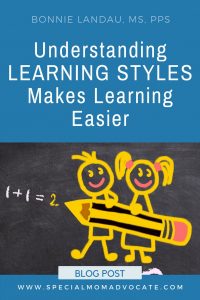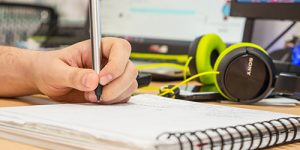 If somebody were to give you driving directions to a place, and you drew a map while listening to the person telling you the directions, which would you recall when going there:
If somebody were to give you driving directions to a place, and you drew a map while listening to the person telling you the directions, which would you recall when going there:
- Would you visual yourself drawing the map?
- Would you see pictures in your head of the surroundings that were described and the turns you would take?
- Would you hear the person telling you how to get there?
Your answer to this question could give a clue of your learning style preference: kinesthetic, visual or auditory.
 Is a learning style a learning disability?
Is a learning style a learning disability?
A learning style is not a learning disability. It is simply a difference in the way a person learns information. There are many theories about learning styles, but the 3 most-accepted learning styles are:
- Visual-spatial learner
- Auditory-linguistic learner
- Kinesthetic-tactile learner
Everybody has a combination of all these learning styles, but generally each individual will have a strong preference for one of the 3. This preference is determined by our genetic makeup and how our brain is wired.
I remember asking my sister the driving directions question above. She said she hears the person giving her the directions, as if she has a tape in her head. She clearly has a strong auditory learning style. I on the other hand will see pictures in my mind, as if I had already driven to the place. I clearly have a strong visual learning style. Others may actually re-draw the map in the air to recall the directions. They would have a kinesthetic learning style.
Schools cater to auditory-linguistic style.
According to the University of Illinois, only 10% of school-aged children have an auditory learning style, yet 80% of school instruction is presented in an auditory fashion. 50% of school-aged children have a kinesthetic learning style while 40% learn best visually. One of the goals of Common Core curriculum is the bring in more visual and kinesthetic experiences, thus broadening the options for how children learn.
Visual and kinesthetic learners are often slower to grasp concepts since they are not taught using their learning strengths. As a result, challenges can show up in all areas of academics and can sometimes look like a learning disability.
Learning to read can be really hard for the visual or kinesthetic learner.
A child can learn to develop one of the learning styles that is not their natural strength. So a child who is visual can strengthen the auditory and kinesthetic approaches, or a child who is auditory can strengthen the visual and kinesthetic approaches.
Reading is often one of the biggest hurdles for children who do not have an auditory learning style. Both my children were significantly challenged when it came time to learn reading, but I was really fortunate to find a program called Easyread.

The creator of Easyread was a struggling reader himself, and he recognized that strong visual learners are often sight readers, memorizing whole words as if they were pictures. Unfortunately when children do this, by the time third grade comes around they are overwhelmed by the number of words they must memorize, and they begin to fail at reading. Sight readers bypass the auditory centers of the brain when reading, and when faced with an unknown word, they do not know how to sound it out. Easyread calls this Optilexia.
Children identified as having dyslexia, auditory processing disorder, or having reading difficulties, often turn out to have a visual learning style. Some are also identified as having an auditory deficit. This means they need to see information in order to understand it. Learning in an auditory fashion is often confusing and difficult, which is why learning to read, an auditory-intensive activity, is so difficult for them.
To help this reading challenge, Easyread uses that visual style to strengthen the auditory component of reading. The system uses visual images to represent sounds, which the child uses to learn the auditory act of decoding (sounding out) the words. With a 95% success rate, Easyread has helped 1000s of children learn to read with this method.
How can I identify my child’s learning style preference?
The best way to identify learning styles is to have an assessment, but sometimes you will just know based on how the child presents information to you:
- Auditory strength: They may repeat verbatim words they have heard or movie lines they have heard.
- Visual strength: They may have the ability to remember visual details with great accuracy.
- Kinesthetic strength: They may use their hands and body a lot when describing an experience, especially acting it out.
ABOUT THE AUTHOR:
Bonnie Landau is a professional counselor and holistic therapist in Ventura County, California. Her specialities include therapy for autism, therapy for ADHD, and therapy for parenting who have kids with autism or ADHD or other neurodivergence. She changed careers from graphic design to counseling with the goal of helping struggling parents of kids with ADHD, autism, or other neurodivergence find strategies and solutions to help their children succeed. Bonnie is also the author of Special Ed Mom Survival Guide: How to Prevail in the Special Education Process and Find Life-long Strategies for You and Your Child.


